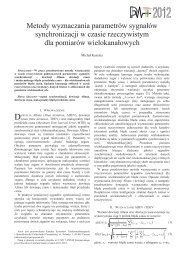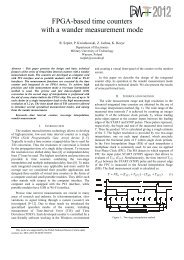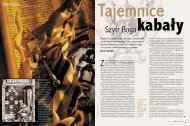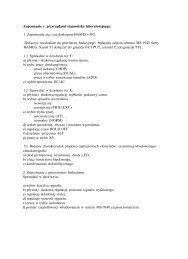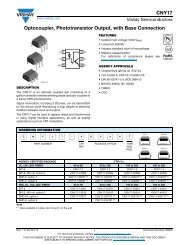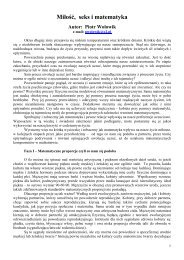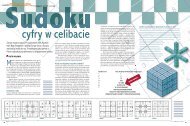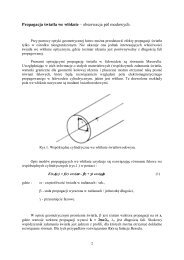WIRELESS
Dynamic Channel Modeling at 2.4 GHz for On-Body Area Networks
Dynamic Channel Modeling at 2.4 GHz for On-Body Area Networks
You also want an ePaper? Increase the reach of your titles
YUMPU automatically turns print PDFs into web optimized ePapers that Google loves.
24 ADVANCES IN ELECTRONICS AND TELECOMMUNICATIONS, VOL. 2, NO. 4, DECEMBER 2011<br />
0.8<br />
0.6<br />
0.4<br />
Still<br />
Walking<br />
Running<br />
90 ◦ Front<br />
I e<br />
ρ i,,j<br />
ρ i,j<br />
0.2<br />
0<br />
−0.2<br />
−0.4<br />
−0.6<br />
0.8<br />
0.6<br />
0.4<br />
0.2<br />
0<br />
Chest/Thigh Chest/Wrist Chest/Foot Thigh/Wrist Thigh/Foot Wrist/Foot<br />
i,,j<br />
Still<br />
Walking<br />
Running<br />
(a)<br />
d l0<br />
r arm d s r arm<br />
Left<br />
φ s Right<br />
r body<br />
180 ◦ d 0 ◦<br />
ab<br />
d ab<br />
Fig. 11. (a) Geometric modeling of the body and the source, (b) Geometric<br />
description of the body and the source in azimuth plane. r body is the trunk<br />
radius, r arm is the arm radius, d ab is the distance between the arm and the<br />
trunk, and d s is the distance from the source to the trunk surface; d l0 =<br />
(r body + d s)φ s is the corresponding distance around the body.<br />
270 ◦<br />
(b)<br />
Back<br />
−0.2<br />
−0.4<br />
−0.6<br />
Chest/Thigh Chest/Wrist Chest/Foot Thigh/Wrist Thigh/Foot Wrist/Foot<br />
i,,j<br />
Fig. 10. Shadowing correlation in measurement campaign 2, Tx placed on<br />
the Hip: anechoic chamber (up), indoor (down)<br />
investigated on-body channels have to be away from the edges<br />
of the body, e.g. the shoulders and the hands. With respect to<br />
measurement campaign 1, three infinite, homogeneous, and<br />
lossy cylinders are applied to model the trunk and the arms of<br />
the body, as in Fig. 11(a). The assumption of homogeneous<br />
cylinders is based on the observation of rapid power decay<br />
when radio waves penetrate the body. All the cylinders are<br />
vertically placed and are allowed to have parallel movements<br />
in the horizontal plane. The size and the initial positions of<br />
the body can be referred in Table. I. The conductivity of the<br />
cylinders is determined by the cole-cole model [21], which<br />
are assumed to be composed by dry skin with respect to the<br />
measurements.<br />
The Tx antenna is simplified into a polarized point source<br />
with constant current intensity. The direction of the polarization<br />
of Tx is described in the global z-polar coordinate, i.e.<br />
the source current is decomposed into polarization components<br />
along the z (tangential polarization along the vertical<br />
direction), φ (tangential polarization along the horizontal direction),<br />
and ρ (normal polarization to the skin) directions.<br />
For computation simplicity, the Tx is fixed at horizontal plane<br />
z = 0, so the fields are symmetric along the z direction. The<br />
Rx antenna is also simplified into a point with its polarization<br />
also described in the z-polar coordinate in the same way.<br />
The positions of the cylinders and the Tx in azimuth plane<br />
can be described in the global z-polar coordinate, as in Fig.<br />
11(b).<br />
The desired on-body channel, given the positions of the Tx<br />
and Rx, is obtained by solving the full-wave fields of the point<br />
source with multiple cylinder scattering. The field solution<br />
contains two steps. First, by [20], the field of the point source<br />
is transferred into the integration of line source fields with<br />
different wave-numbers along z and ρ directions as:<br />
E point (ρ, φ, z) = 1<br />
2π<br />
∫ −∞<br />
−∞<br />
E line (ρ, φ)(k z )e −jkz z dk z , (7)<br />
where k z is the wave-number along the z direction. The<br />
singularity problem in the integration is also well described<br />
in [20].<br />
Secondly, for each line source, the multiple cylinder scattering<br />
is solved by applying the addition theorem by [22] to<br />
explicit the interacting processes of the scattered fields from<br />
different cylinders. In general, the field solution is an iterative<br />
process described by the boundary condition, which can be<br />
understood as that the scattered fields of each cylinder excited<br />
by the initial incident field from the source will re-excite<br />
higher order scattered fields when they reached the surfaces<br />
of the other cylinders, as described as:<br />
E s,p<br />
1 = E i,p + E s,p<br />
2 +<br />
P∑<br />
E s,q , (8)<br />
q≠p<br />
where E s,p<br />
1 and E s,p<br />
2 stand for the scattered fields from<br />
cylinder p inside and outside the surface of cylinder p, E i,p<br />
stands for the incident field from the polarized source at the<br />
surface of cylinder p, and E s,q stands for the scattered fields<br />
from the other cylinders arriving at the surface of cylinder<br />
p. The complete full-wave field solution of each polarization<br />
component (z, ρ, φ) is well described in [23]. An efficient<br />
algorithm for a numerical approximation can be found in [24],<br />
[25]. The model provides a general field solution with arbitrary<br />
polarization of the Tx and Rx.<br />
When the on-body channel is distributed on the horizontal<br />
plane and both the Tx and Rx are in z-polarization, a simplified<br />
field solution can be realized by considering the field solution<br />
of a z-polarized line source with multiple cylinder scattering.<br />
A simulation example is shown in Fig. 12 to compare the<br />
effect of the joint arm-trunk scattering to the trunk scattering<br />
in the azimuth plane. The shadowing effect at the back of the<br />
trunk, and the interference from the arm scattering are clearly<br />
observed.<br />
The dynamic body scattering is modeled by extending the<br />
above static field solution into a series of time-consecutive<br />
scenarios with different positions of the arms at the azimuth



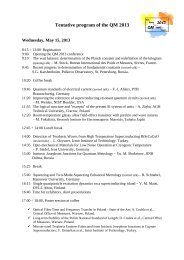


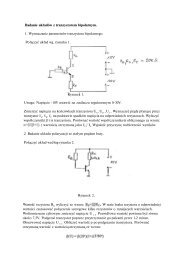
![1RUPDOQH \FLHFKU]H FLMD VNLH](https://img.yumpu.com/54031532/1/184x260/1rupdoqh-flhfkuh-flmd-vnlh.jpg?quality=85)

